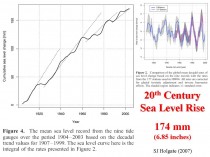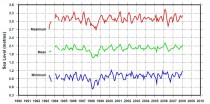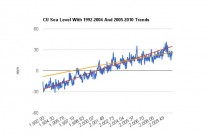By John O’Sullivan, Suite 101
Science professor, a former global warming believer now denier, publishes groundbreaking paper to prove carbon dioxide cools, not warms our atmosphere.
Professor Nasif Nahle found something deeply troubling about the man-made global warming theory (AGW). He explains, “I started out wanting to debunk those deniers of science.”
Nahle had originally believed that human emissions of carbon dioxide (CO2) were warming the atmosphere until he found an incorrect assumption on the Greenhouse Effect hypothesis.
Invited to attend a televised debate on the Indonesian Tsunami that addressed whether global warming was a factor in that catastrophe, Nahle checked the validity of calculations into the so-called greenhouse effect. “That was when I saw it was junk science.”
Nahle, from the Autonomous University of Nuevo Leon in Monterrey, N. L., Mexico, has worked professionally as a scientist for over 40 years. His findings are set to add more fuel to the fire in the vigorous debate over the validity of a cornerstone of the science of environmental activism.
In his new paper, ‘Determination of the Total Emissivity of a Mixture of Gases Containing 5% of Water Vapor and 0.039% of Carbon Dioxide at Overlapping Absorption Bands’ the Mexican biologist turned climate researcher proves that in nature, CO2 and water vapor mix together to decrease infrared radiation emissions/absorptions in the air. This is the opposite of what conventional climatology has been saying years.
Global Warming Scare is “Anti-science”
In an astonishing personal U-turn Nahle has taken on the task of demonstrating that the demonization of CO2 was premised on a faulty hypothesis. Nahle completed his controversial study with the assistance of American physicist, Dr. Charles Anderson. Anderson is one of eight coauthors of the controversial book, ‘Slaying the Sky Dragon’ that also falsifies the ‘greenhouse gas’ effect. Nasif says, “Dr. Anderson and I found that the coolant effect of the carbon dioxide is stronger when oxygen is included into the mixture.”
Nasif says, “To my surprise, I found that the hypothesis was flawed and that the AGW proponents were inventing variables and constants. As I starting to apply the correct data and algorithms, I was realizing that the whole hypothesis was wrong from the physics standpoint.”
The 60-year-old’s career is now firmly focused on climate-related research; in 2010 he began working on Climate Change and Biodiversity at the Superior School of Biology, University Juarez of the State of Durango. Nahle is so converted in his thinking that he now calls the greenhouse gas theory, “antiscience” and “pseudoscience.”
Other science specialists in the fields of atmospheric physics, astrophysics, chemistry and biology as well as mathematicians, have also been looking with a critical eye on the controversies in climate science ans publishing papers going against the views of establishment climatology, a science largely comprised of generalists not specialist scientists, according to Canadian climatologist, Dr. Timothy Ball. Ball concurs with such skeptic criticisms adding that it “raises questions about who is qualified to provide oversight.”
As scepticism about global warming increases I asked Nasif why it has taken so long for more independent scientists to speak out. He replied, “In my experience, other scientists follow the mainstream about the greenhouse effect (GHE) without examining its basis. If they would examine the issue in more depth like I did, they would realize that it is not true; the GHE just doesn’t exist.”
Carbon Dioxide Shown to Have no Potential to Trap Heat
Professor Nahle’s paper addresses very technical matters such as “emissivity” and “overlapping absorption bands” within atmospheric gases which many scientists, as well as non-scientists, have little real understanding. So I asked Nasif to give an explanation.
“Emissivity is a coefficient which determines the potential that any thermodynamic system has to emit energy. If the emitted energy is of its own, like the energy emitted by the Sun, the thermodynamic system is a primary source of energy. If not, like the gases in the atmosphere and the materials of the surface, it is not a primary source of energy and only can emit the energy it absorbs.”
Nasif’s study looked at how well gases in our atmosphere convert energy from the sun to raise temperatures on the ground. He went on, “In the case of carbon dioxide, its emissivity consists of its potential to emit the energy absorbed because it is not a primary source of heat.”
Nasif added, “the absorptivity coefficient of the carbon dioxide is equal to its emissivity coefficient, the gas can only absorb a limited amount of the energy received from other sources and then emit a limited amount of the energy absorbed.” In simple terms this means carbon dioxide cannot ‘store’ more energy than it emits.
Poor Climate Calculations Overestimated Warming Effect
This new study, in effect, refutes the claims of climate doomsaying researchers who say such an overlapping trapping effect ‘enhances’ the emissivity of the carbon dioxide and/or the water vapor in the air (clouds, etc.).
Such energy received is then swiftly lost to where it goes most easily i.e. to the colder regions of the upper atmosphere and then to outer space. This means heat does not get ‘trapped’ in the absorption bands of the gases and the atmosphere cannot thereby act as a ‘blanket’ to keep the earth’s surface warm.
In fact, in total contradiction of global warming orthodoxy, Nahle’s research demonstrates that, under these conditions, a negative emissivity occurs; a self absorption that must be subtracted from the addition of total emissivities of the two, three, four, or more gases. Thus the only effect CO2 can have on global climate is to reduce temperatures, not increase them.
Read more at Suite101. Greenhouse Gas Theory Discredited by ‘Coolant’ Carbon Dioxide
By Peter Glover, Energy Tribune
"The global warming hysteria is well and truly over. How do we know? Because all the relevant factors - polls, news coverage, government u-turns and a manifest lack of interest among policy makers - show a steep decline in public concern about climate change.” Dr Benny Peiser, director of the UK’s Global Warming Policy Foundation, was speaking for the motion ‘The Global Warming Concern is Over, Time for a Return to Sanity’ at a public debate hosted by the UK’s Spectator magazine at The Royal Geographic Society in March. The London audience having heard an evening of hard facts openly debated, duly voted 428 in favor of the motion, 214 against, 31 undecided.
An insignificant representative sample you might think. Except it’s not the first time genuinely open debate - which we rarely get in the media - before a packed public audience on climate issues has delivered a ‘sceptic’ vote. In a 2007 public debate, organized in New York by Intelligence Squared, an audience considered the motion “Global Warming is Not a Crisis”. Pre-debate the vote taken showed only 30 percent agreed with the motion, 57 percent against with 13 percent undecided. Post-debate the percentages revealed around 46 percent now for the motion, 42 percent opposed and 12 percent undecided. It seems whenever hard facts are to the fore in genuine debate on global warming/climate issues alarmists lose. But then facts have always had a nasty habit of biting the alarmist bandwagon where it hurts most - in the intellect.
More significantly for politicians, is the growing evidence that signing ‘green’ economic suicide notes and presenting a clear and present danger to jobs and business is a fast-track to losing at electoral polls too.
For the general public has no confidence in the carbon jihad and Warmageddon’s been deferred. The political elites have yet to get the message.
Carbon Jihad
While a UK ‘Climate Week’ poll in March that revealed around 75 percent of older Brits had doubts or simply did not believe global warming is a threat, the UK coalition government, in its spring Budget, announced that Britain would be the first to legislate for a carbon floor price - at 16 pounds (US$25) per ton from 2013. Even leading socialist MP Nias Griffith recognized the massive economic damage the move would inflict: “The carbon floor price is like a super tax on the UK’s manufacturing industry. It would make us uncompetitive even compared to our European competitors, and will drive companies abroad”. Her view was quickly echoed by the heads of industry.
While UK chancellor George Osborne was proclaiming the move would “provide incentive for billions of pounds of new investment in our dilapidated energy infrastructure”, Karl-Ulrich Kohler, head of Tata Steel’s European operations, was pointing out the obvious flaw. Kohler sees the introduction of a carbon floor price as representing a “severe blow to the sustainability of UK steelmaking” by inducing higher costs for electricity-generation, hitting all the energy-intensive industries.
The introduction of the carbon floor price has already been described, even by the flag-waving pro-alarmists at the BBC, as a “green suicide note” with warnings of increasing hardship resulting for the poor and elderly. Even anti-carbon groups were sceptical about the move. Point Carbon reported an EU spokesman saying of the UK Government’s decision, “Under the given (EU emissions) cap, more reductions in the UK will simply be offset by fewer reductions in other member states”. In plain layman’s language: whatever the unilateral UK carbon price plan achieves, its net effect on emission cuts in the greater European carbon jihad, will likely be nil. At the beginning of April, the EU published figures that showed carbon emissions across Europe, far from being reduced, rose in 2010 by 3.5 percent, the first rise in three years.
And if David Cameron wanted evidence for just how toxic setting a carbon tax would be politically, he should take heed of how similar efforts have inflicted steep political decline on Australian PM Julia Gillard’s chances of re-election. Gillard’s fight to introduce a carbon tax has already seen her lose a critical regional election in New South Wales (NSW) by the largest margin in her party’s history. Gillard wants to impose a 30 percent tax on the country’s iron ore and coal profits by 2012. With NSW, Western Australia and Victoria’s mining resources contributing 67 percent of Australia’s AUS$1.3 trillion economy, the public is only too aware of the link between carbon floor fixing and the threat to energy-intensive industry jobs, not to mention international competitiveness.
Meanwhile, in the US, Obama’s attempt to push expensive green energy projects is proving a difficult sell to a populace which, according to the latest Gallup Poll rates global warming bottom among its environmental concerns. Just 51 percent of Americans are now concerned “a fair amount” or more about global warming, down from 66 percent in 2008. Even fewer believe global warming is a largely man-made phenomenon. US opinion polls generally, reveal global warming ranks way down the list of national concerns. None of this should be surprising given that carbon dioxide contributes just 3 percent of total CO2 emissions, and that CO2 itself is a minor greenhouse gas. But hey, were talking opinion here, let’s not get hung up on hard facts - precisely the point being made by Benny Peiser at the recent London debate. Peiser was essentially arguing that the science has become irrelevant in the current climate debate, the public having largely made its mind up, as one observer put it to, “vote out any party that pushes the green line too far”.
Roger Helmer, a British member of the European Parliament, summed up the current disconnect between political and public priorities on climate more forcefully: “The public are sick of the climate change debate, and resentful at being constantly blamed every time they drive a car or fly to Majorca. We don’t believe it, we won’t vote for it, we won’t pay for it. And the sooner the government catches up with the mood, the better.”
But that’s hardly likely to slow down the ‘green’ social engineers who perceive global warming as a tool to achieve broader social changes. The trouble is, when it comes to global warming alarmism, believers have hit a public opinion wall known as Downs’ Syndrome.
Downs’ Syndrome
Back in 1972 Anthony Downs, a public policy and administration scholar who served as advisor the Lyndon Johnson White House, conceived what he called the public concern “issue-attention cycle”. According to Downs’ theory, while environmental events can trigger public concern, whether those problems are resolved or not, boredom and fatigue steadily sets in. This, Downs claimed, is exacerbated where huge costs are involved in solving societal problems. Commenting on the theory, Benny Peiser points out, “Unless a significant warming trend re-emerges in the next ten years” - a trend which has flat-lined over the past decade while carbon emissions globally continued to rise - “it will be near impossible to revive climate change as a major concern”.
Bottom line: planetary apocalypse or not, green politics can seriously damage your wealth - and your electoral chances.
by Robert P. Smith, Ph.D., P.E. in SPPI
As a long-term subscriber to Practical Winery & Vineyard Journal I have always looked forward to the regular features of Dr. Richard Smart. Sunlight Into Wine was a landmark contribution to viticulture.
Nevertheless, I was surprised and disappointed to read his article “Reducing CO2 - the REAL pollutant” in the Spring 2011 edition. As an environmental scientist and engineer, I am particularly attuned to the use of the word “pollutant.” I have spent my professional career dealing with real pollution, so when I see CO2 - an essential and beneficial substance in our environment - so characterized, I am compelled to respond.
As we both know - or should know - carbon dioxide is plant food. Other nutrients are needed, but CO2 is a plant’s only food, it cannot survive without it. Carbon dioxide - replenished through the carbon cycle - is the source of the carbon utilized to produce carbohydrates through photosynthesis. Without plants of course, we animals could not survive.
Dr. Smart, with all due respects to his contributions to viticulture, appears out of his depth on climate change. He is, of course, taking the politically correct position that added CO2 will cause an enhancement of the greenhouse effect, leading to a dangerous increase in earth’s temperature, i.e., global warming. While this opinion is widely proclaimed among climate alarmists, it is exactly that, an opinion and nothing more. There is no empirical evidence whatsoever that CO2 recently caused, or will in the future cause global warming of any significance. None.
Information supporting the manmade global warming theory is largely based upon a short term historical correlation between CO2 and temperature, and computer models. These computer models have a poor record in forecasting (or even hindcasting) climate events. Empirical evidence - not failed computer models - supports a climate that is driven by natural processes, e.g., solar cycles, ocean currents, orbital dynamics, and longer term, continental positioning from geological plate tectonics. It has been so for hundreds of millions of years and continues today.
In this article Dr. Smart states “The majority of the world’s climate scientists agree that recent evidence of global warming can be linked to increasing atmospheric CO2 levels, increasing largely because of human activity.” Fact: Over 700 internationally recognized scientists provided testimony to the U.S. Senate refuting the theory of manmade global warming (U.S. Senate Minority Report on Global Warming, March 16, 2009.) Good science isn’t done by polls, nevertheless no credible survey of scientist’s positions has ever been conducted. This statement is unsubstantiated personal opinion.
It is a well-documented fact that more carbon dioxide in the atmosphere increases the efficiency of plant growth. As we burn fossil fuels and increase the trace levels of atmospheric CO2, our agriculture flourishes and produces more food with less water. (See The Many Benefits of Atmospheric CO2 Enrichment, Drs. Craig and Sherwood Idso, 2011, Vales Lake Publishing, LLC.)
We in the wine industry face many challenges, not the least is access to affordable and reliable energy. We should not be wasting scarce resources on popular theories that lack solid empirical evidence.
An Honest Climate Debate
Sydney Morning Herald
8 April 2011
A SYDNEY carbon credits company thought to have been running some of the world’s biggest offsets deals appears to be a fake, shifting paper certificates instead of saving forests and cutting greenhouse emissions.
Shift2neutral says it has made high-profile events such as the Australian PGA golf championship and the Sydney Turf Club’s world-first “green race day” carbon neutral.
But deals to generate more than $1 billion worth of carbon credits by saving jungles from logging in the Philippines, the Congo and across south-east Asia do not seem to exist.
The global network of investors and carbon offset certifiers supposed to be brokering deals with foreign presidents and the World Bank can be traced to a modest office in a shopping village in Westleigh, staffed by shift2neutral’s founder, Brett Goldsworthy.
Mr Goldsworthy insists every certificate for carbon offsets he issues has value and represents a real reduction in greenhouse emissions somewhere in the world. That is what he has told puzzled investors and companies who have unwittingly sought to reduce their carbon footprint.
But when pressed for examples of any specific project that has cut emissions to generate the carbon credits the company offers for sale, he was unable to provide even one.
Read more here.
ICECAP NOTE: Carbon trading is a lot like ”Pet Rocks” a 1975 fad originated in California by salesman, Gary Dahl.

They spread like wildfire to the rest of the country. What was commonplace and essentially worthless suddenly became something people paid for. They made money for Dahl, carbon credits are making a lot of money for scam artists like Al Gore, Brett Goldsworthy and so many others and for governments on all scales. A number of green trading scams were uncovered in Europe. Like the Bernie Madoff scam, we the people and organizations we may work for are the big losers. H/t Marc Morano.
By Steven Goddard
This story is being spread around the Internet:
Can the cherry blossom tell us anything about climate change?
Yes, says Dr. Yasuyuki Aono of the Osaka Prefecture University. Since the mid-1990s, Aono and his colleague Yukio Omoto have been unearthing records of cherry blossom festivals in the former capital of Kyoto and nearby towns going back to the 9th century. Using the dates of the festival given in the records, and an equation that calculated the temperature in March of a given year based on when the cherry blossoms flowered, Aono was able to estimate March temperatures in the Kyoto area for the past 1200 years, a full thousand years farther back than most temperature data is available for.
The findings would not please climate change deniers: Aono found that recent flowering days are earlier than any in the past 1200 years.
Here is the abstract of Aono’s most recent paper, which says the exact opposite.
We investigated documents and diaries from the ninth to the fourteenth centuries to supplement the phenological data series of the flowering of Japanese cherry (Prunus jamasakura) in Kyoto, Japan, to improve and fill gaps in temperature estimates based on previously reported phenological data. We then reconstructed a nearly continuous series of March mean temperatures based on 224 years of cherry flowering data, including 51 years of previously unused data, to clarify springtime climate changes. We also attempted to estimate cherry full-flowering dates from phenological records of other deciduous species, adding further data for 6 years in the tenth and eleventh centuries by using the flowering phenology of Japanese wisteria (Wisteria floribunda). The reconstructed tenth century March mean temperatures were around 7C, indicating warmer conditions than at present. Temperatures then fell until the 1180s, recovered gradually until the 1310s, and then declined again in the mid-fourteenth century.
Even worse is the fact that Aono blames recent warming in the cities on UHI (PDF).

Enlarged
Not a hint of truth being presented by the MSM.
By Science Daily
Between 75 and 80 per cent of all volcanic activity on Earth takes place at deep-sea, mid-ocean ridges. Most of these volcanoes produce effusive lava flows rather than explosive eruptions, both because the levels of magmatic gas (which fuel the explosions and are made up of a variety of components, including, most importantly CO2) tend to be low, and because the volcanoes are under a lot of pressure from the surrounding water.
Over about the last 10 years however, geologists have nevertheless speculated, based on the presence of volcanic ash in certain sites, that explosive eruptions can also occur in deep-sea volcanoes.
But no one has been able to prove it until now.
By using an ion microprobe, Christoph Helo, a PhD student in McGill’s Department of Earth and Planetary Sciences, has now discovered very high concentrations of CO2 in droplets of magma trapped within crystals recovered from volcanic ash deposits on Axial Volcano on the Juan de Fuca Ridge, off the coast of Oregon.

These entrapped droplets represent the state of the magma prior to eruption. As a result, Helo and fellow researchers from McGill, the Monterey Bay Aquarium Research Institute, and the Woods Hole Oceanographic Institution, have been able to prove that explosive eruptions can indeed occur in deep-sea volcanoes. Their work also shows that the release of CO2 from the deeper mantle to Earth’s atmosphere, at least in certain parts of mid-ocean ridges, is much higher than had previously been imagined.
Given that mid-ocean ridges constitute the largest volcanic system on Earth, this discovery has important implications for the global carbon cycle which have yet to be explored.
This research was funded by: R.H.Tomlinson, GEOTOP, and J.W. McConnell Memorial Fellowships; the David and Lucille Packard Foundation; and the Natural Sciences and Research Council of Canada (NSERC).
By Willis Eschenbach, Watts Up With That
Bill McKibben, the skeptics best friend, can always be depended on to provide interesting claims. Never one to let a good crisis go to waste, he opines on the tsunami and our “shrinking margins” over at the Guardian. A number of people have highlighted various of his ideas, not all of them favorably. One claim of his that I have not seen discussed is the following:
We’re seeing record temperatures that depress harvests - the amount of grain per capita on the planet has been falling for years.
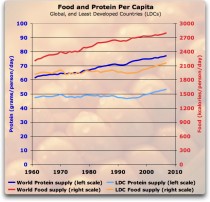
Figure 1. Food and Protein per capita. The LDCs are the “Least Developed Countries”, the poorest of the world’s countries. Red and orange are total food supply (right scale). Dark and light blue are protein (left scale). DATA SOURCE
Let’s start by considering the real issue. People eat a host of things, not just grains. So the issue is not the number of kilogrammes of grain produced per person. That’s only part of the story. The real issue is, how well are we feeding the ~ 7 billion people of the world?
The first thing that Figure 1 shows is that after years of making little gain, since the early 1990s the food supply in the LDCs has been improving (orange line). There’s still a ways to go, but the trend is upwards.
The next thing is quite surprising. In the year 2007 (the last year for which we have data), the people in the poorest countries (orange line) were getting almost as many daily calories as the global average in 1961 (red line). To me, this is an amazing accomplishment. Remember that during this time, the population of the planet more than doubled. Despite that, both the poorest of the poor, and the global population as a whole, are better fed than at any time in history.
Finally, globally there is no sign of any recent decrease in nutrition levels. Nor do nutrition levels appear to be connected in any way to the temperature.
However, to be fair, that wasn’t McKibben’s claim. He said that grain production per capita on the planet has been “falling for years”, so let’s check that. Figure 2 shows those numbers, with the data again from FAOSTAT.

Figure 2. Production per capita for all cereal grains. Figures for the LDCs represent domestic cereal production divided by domestic population.
Has global grain production per capita been “falling for years” as McKibben claims? The observations say no. Globally, it peaked at just above 350 kg per person around 1980 and has dipped less than 10% and come back up since then.
For the LDCs, on the other hand, their domestic cereal grain production was unable to keep up with their domestic population growth until the early 1990s. Since then, due in part to decreasing population growth rates, LDC grain production per capita has been rising steadily. There’s no sign of any recent change in that rising trend. Anything is possible tomorrow, of course. But there’s no sign of falling grain production as McKibben claims, from temperature or any other cause.
So, what’s the current score in the battle of the farmers of the planet to feed the ever-increasing masses?
Farmers: 1 ... Malthus: 0.
Oh, and McKibben’s score? ...-1 for truth content, but high marks for entertainment value.
w.
PS - The continued ability of the world to feed itself, despite adding a total of four billion people to the planet in the last fifty years, is an unparalleled and largely unrecognized success for humanity. I am so tired of people like McKibben not only not acknowledging that, but going so far as to claim that the trend has reversed and that things are getting worse. That’s nonsense. In terms of world nutrition, things are better than they have ever been, even for the poorest countries. Not only that, but they continue to improve. That’s a huge success.
So rather than incessant whining about how terrible things are, how about we take some pride in that success, and think about what it is we’ve done right to achieve that, and how to do more of whatever that was that got us here?
By Paula Scully
UPDATE: See these two important reports on sea level, one by Nils Axel Morner, this part I of a an excellent two part study by John Droz.
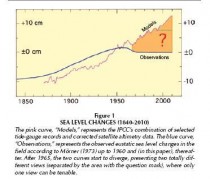
Enlarged. Morner shows how the trend is almost entirely due to unwarranted “adjustments” much like we find with global temperatures.
------------
While the economy may be the most immediate issue, climate change is on our doorstep, said Melanie Reding, education coordinator for the Jacques Cousteau Coastal Education Center in Little Egg Harbor.
Reding spoke Saturday about sea level rise and what warming oceans mean for New Jersey’s coast, to an audience at the Long Beach Island Foundation of the Arts and Sciences.
“New Jersey has a real issue,” Reding said. “Sixty percent of our population lives within the coastal region. We have low elevation and high population.” The sea level at Atlantic City has risen about 14 inches since records began in 1912, half because of the rise in sea level and the other half to subsidence - sinking of the land.
Reding cited an article reporting that 97 of 100 climate experts say humans are changing global temperatures. The article, “Examining the Scientific Consensus on Climate Change” by P. Doran and M. Zimmerman, was published in 2009 in Eos, Transactions, American Geophysical Union. “From the media, you’d think there is a debate,” she said. While public opinion remains divided, climatologists agree that climate change has accelerated, she said.
ICECAP NOTE: First that 97% number study which was even used in congress by Waxman and others is not what it seems and does not as Reding claim reflect the opinion of 97 of every 100 scientists that the global warming science is solid and settled.
The number stems from a 2009 online survey of 10,257 earth scientists, conducted by two researchers at the University of Illinois of whom 3,146 responded, less than a 31% response rate. Of that number, only 5% described themselves as climate scientists, numbering 157. The authors reduce that by half by only counting those who they classed as “specialists”. So the researchers used just 79 respondees for their report. Not exactly a survey of the ‘worlds climate scientists’.
Of these specialists, 96.2% (76 of 79) answered “risen” to question 1 and 97.4% (75 of 77) answered yes to question 2. The two questions were worded such that any climate scientist pro man-made or those who believe natural factors dominate would have responded yes.
The first question asked whether the earth has warmed since before 1800. Since before 1800, the earth was in the Little Ice Age, it would have been unreasonable to respond no. The second asked whether man has been responsible for warming. Since 30-50% of the observed warming has been shown by dozens of peer review papers to be the result of urbanization and land use changes, even those of us who believe the rest is primarily due to ocean and solar cycles, would have answered yes. The Scientific American on-line poll of scientifically literate readers, recently pulled, was probably closer to the truth. With a total of 5190 respondents, a consensus of 81.3% think the IPCC is “a corrupt organization, prone to group-think, with a political agenda” and 75% think climate change is caused by solar variation or natural processes vs. 21% who think it is due to greenhouse gases from human activity.
As for sea level rises, Holgate (2007) has shown a deceleration below the lowest rate of the range specified by the IPCC.
The islands of the Pacific are claimed to be the most threatened with rising sea levels by the IPCC.
Dr. Cliff Ollier reviews sea level rise for “Tuvalu, the favourite island to be doomed by sea level rise driven by global warming, allegedly caused by anthropogenic carbon dioxide. If you look up Tuvalu on the internet you are inundated with articles about its impending fate. Tuvalu has become the touchstone for alarm about global warming and rising sea level. He shows the data from the Australian BOM shows no changes for 20 years.”
More generally, Dr. Vincent Gray in this analysis wrote:
“The SEAFRAME sea-level study on 12 Pacific Islands is the most comprehensive study of sea level and local climate ever carried out there. The sea level records obtained have all been assessed by the anonymous authors of the official reports as indicating positive trends in sea level over all 12 Pacific Islands involved since the study began in 1993 until the latest report in June 2010. In almost all cases the positive upward trends depend almost exclusively on the depression of the ocean in 1997 and 1998 caused by two tropical cyclones. If these and other similar disturbances are ignored, almost all of the islands have shown negligible change in sea level from 1993 to 2010, particularly after the installation of GPS leveling equipment in 2000.”
Gray notes that the claimed trends of 3.7 to 9.2 mm/year do not match the measured trends which are zero for up to 18 years.
See again here how sea level rises have actually slowed in recent years (source NOAA lab at UCO) with a only a brief pop with the El Nino of 2009/10 as oceans briefly expanded with the El Nino warmth).
To her credit, Reding did acknowledge that subsidence of the land was responsible for part of the sea level rise. In most places where the sea level rises are larger than average subsidence is a key issue.
Today this from Bob Carter is more peer review evidence that sea levels are not accelerating.
An important new paper, which confirms again that no sea-level acceleration can be detected (thanks to Willem and John Droz, who forwarded it).
HOUSTON, J.R. and DEAN, R.G., 0000. Sea-level acceleration based on U.S. tide gauges and extensions of previous global-gauge analyses. Journal of Coastal Research, 00(0), 000–000. West Palm Beach (Florida), ISSN 0749-0208.
Without sea-level acceleration, the 20th-century sea-level trend of 1.7 mm/y would produce a rise of only approximately 0.15 m from 2010 to 2100; therefore, sea-level acceleration is a critical component of projected sea-level rise. To determine this acceleration, we analyze monthly-averaged records for 57 U.S. tide gauges in the Permanent Service for Mean Sea Level (PSMSL) data base that have lengths of 60-156 years. Least-squares quadratic analysis of each of the 57 records are performed to quantify accelerations, and 25 gauge records having data spanning from 1930 to 2010 are analyzed. In both cases we obtain small average sea-level decelerations. To compare these results with worldwide data, we extend the analysis of Douglas (1992) by an additional 25 years and analyze revised data of Church and White (2006) from 1930 to 2007 and also obtain small sea-level decelerations similar to those we obtain from U.S. gauge records.



